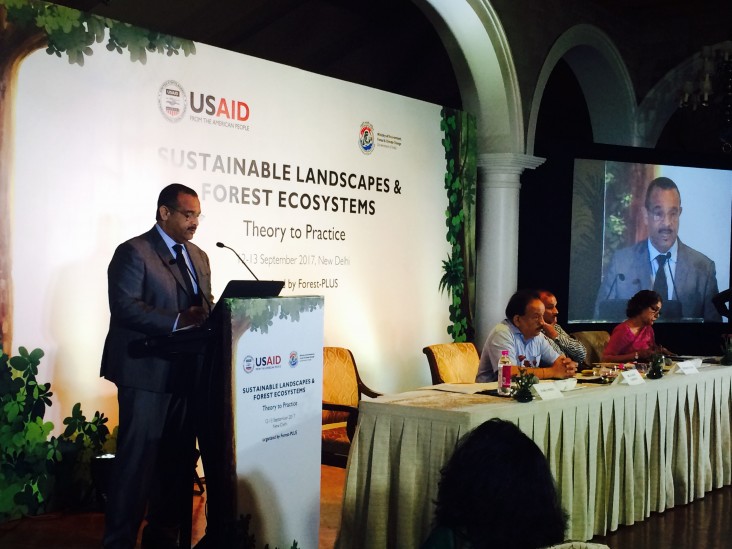
(As prepared for delivery)
Good morning ladies and gentlemen. On behalf of the United States Agency for International Development and our partner the Ministry of Environment, Forest and Climate Change, it gives me great pleasure to welcome you all to this conference on “Sustainable Landscapes and Forest Ecosystems”.
I would like to extend a warm welcome and my heartiest congratulations to Dr. Harsh Vardhan on his appointment as India’s new Minister of Environment, Forest and Climate Change. Dr. Harsha Vardhan, as Minister of Science and Technology, your support of USAID's Millennium Alliance program, which nurtures India's innovative talents was greatly appreciated, and we look forward to working with you in that same spirit and enthusiasm.
I would like to begin by thanking you for the strength of our U.S.-India partnership.
For decades, USAID has been privileged to partner with India to improve land management. In this arena, Indian agencies and USAID’s joint objectives have focused on improving the productivity and health of natural resources for India’s people, and to share these successes and best practices with others around the world. Those objectives have been consistently realized.
For example, innovations fostered in the Green Revolution of the 1960s are credited with improving the productivity of agriculture worldwide and improving the quality of life for billions.
During the 1980s, USAID supported the Government of India’s social forestry program in several Indian states. The goal was to meet the growing needs of India’s rural population for fuelwood, fodder, small timber and other forest products by promoting planting of trees outside traditional forest reserves.
Today India and the world are transitioning from a primarily rural to a primarily urban population. Many people are still directly dependent on forest products for livelihood support, and those needs cannot be neglected.
Of growing importance for the global population, however, are the ecosystem services that forests afford. These services include provision of clean, dependable water; carbon sequestration; biodiversity; and timber and non-timber forest resources.
As the global population grows, both the demand for these ecosystems services and the pressures for conversion of the ecosystems themselves will only increase. To balance these competing needs, a growing body of work has focused on using an integrated landscape approach to manage forests and surrounding lands. Only with integrated planning can societies’ goals be realized.
To help reach those goals, USAID has worked through the Partnership for Land Use Science (Forest-PLUS), a joint effort of the Government of India’s Ministry of Environment, Forest and Climate Change and USAID.
Over the past five years, the program has developed a rich body of approaches and tools for an ecosystem approach to forest management in India, with a special focus on REDD+ (Reducing Emissions from Deforestation and forest Degradation).
These include, for example, management techniques to help improve the ecological health of Indian forests, the forest carbon stocks, and the livelihoods of people who depend on the forest. The program has also developed forest data models using remote-sensing technology to measure forest carbon and the condition of forests in India. To help us better estimate how much carbon is locked up in the forests, the program has also developed a Forest Data Management System that combines data from the field with remote-sensing.
Co-developed by leading Indian and American scientists, forest managers, and development specialists, these Forest-PLUS products are both innovative and grounded in the realities of management in India.
Forest-PLUS has tested these new tools and methodologies to ensure they make the most useful contribution to India's efforts. At the district level, it has developed a REDD+ project covering parts of Shimoga in Karnataka [CAR-NOT-ahKA] for the voluntary carbon market. This will improve the forest and also provide payments to the local communities for their contributions. Our U.S.-India cooperation is also focusing on how to work on a much larger scale, extending our project’s coverage to the entire state of Sikkim and two districts in Madhya [MUD-YA] Pradesh.
In the process of developing these approaches, the program has also deepened an understanding of the issues and solutions in this field.
The technical sessions you participate in over the next two days will take a deeper look at these issues, and pave the way for much needed discussions on opportunities and challenges for forest and landscape management in India.
Having worked and served worldwide, I know that progress is never linear and that solutions are never simple. But, it is exactly the difficult problems that USAID was founded to solve – and we can only do that through strong and committed partnerships. I am pleased that through Forest-PLUS, we have demonstrated the power of partnerships to address some issues that affect all of us on the planet we share.
In the end I would like to add that with an enthusiastic Minister in Dr. Harsh Vardhan and the determined Ministry of Environment, Forest and Climate Change, I am confident India will achieve the goals it has set for herself.
Thank you.







Comment
Make a general inquiry or suggest an improvement.